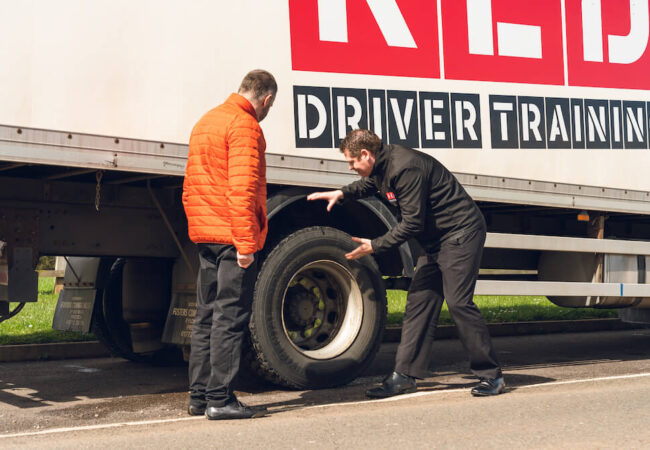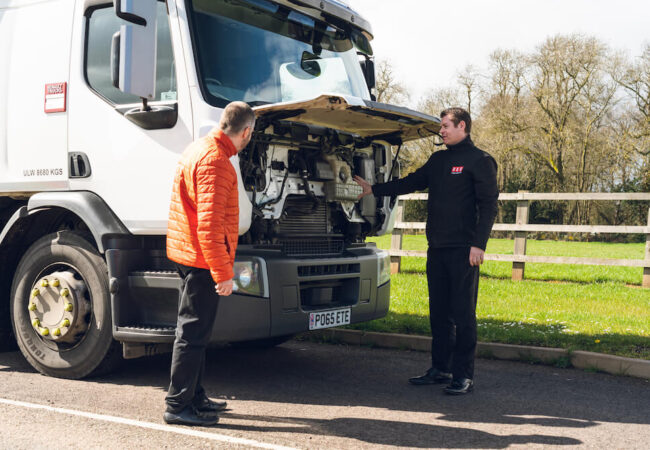
Brexit & EU Workers: One of the primary factors contributing to the HGV driver shortage in the UK is the aftermath of Brexit. Many EU nationals who worked as HGV drivers in the UK have left due to uncertainties surrounding their status and the additional paperwork required. This has resulted in a significant reduction in the available workforce.
Pandemic-Related Challenges: The COVID-19 pandemic exacerbated the situation by causing disruptions to driver training and testing, as well as leading to a backlog in the licensing process. Lockdowns and restrictions also discouraged potential drivers from entering the industry.
Ageing Workforce: The HGV driver industry in the UK has an ageing workforce, the average age of a truck driver in the UK is 53 and only 2% are under the age of 25 – this demographic challenge has contributed to the shortage and will only exacerbate the issue in the future.

Streamlining Training & Licensing: To ensure a steady supply of qualified HGV drivers it is essential to streamline the training and licensing process – something RED’s HGV training and license checking courses offer. The government also needs work with industry stakeholders to expedite the training and certification of new drivers while maintaining rigorous safety standards.
Attracting New Talent: Encouraging younger individuals and underrepresented groups to pursue HGV driving careers is crucial. Initiatives to promote the profession, including apprenticeships and outreach programs, can help make the industry more appealing to a broader audience.
Retaining & Up-skilling Current Drivers: Keeping experienced drivers in the industry is as important as attracting new talent. Offering competitive wages, better working conditions, and opportunities for career progression can help retain skilled drivers and make the profession more appealing.
Addressing Brexit Concerns: The government should work to provide clarity and stability for EU nationals working in the UK, as well as simplify the process for new drivers coming from the European Union. Reducing bureaucratic hurdles can help attract and retain foreign drivers.

Significant advancements are occurring in driverless technology. However, the question remains: can this innovation entirely replace truck drivers, or will it instead redefine their roles?
Technological Challenges: The application of driverless technology to Heavy Goods Vehicles (HGVs), is still years away from being a reality.
Financial Implications: The adoption of new technology is extremely costly. Initially, only larger logistics companies may have the financial capacity to implement such technology, leaving smaller entities to await its broader accessibility.
Continued Need For Drivers Even in a scenario where autonomous trucks are globally implemented, the requirement for human drivers would persist. The demand for truck drivers might even escalate, given the potential risks associated with the absence of a driver in the cab.
The HGV driver shortage crisis in the UK has highlighted the vulnerability of the supply chain and the need for comprehensive solutions. To avoid a similar crisis in the future, it is essential to address the root causes of the shortage, streamline training and licensing processes, attract new talent and retain experienced drivers. With RED, the journey to becoming an HGV driver becomes a seamless and supported experience. From comprehensive training programs to a network of experienced professionals, RED provides the essential tools to help address the HGV shortage in the UK.
Corporate driver licence checking managed online with an easy-to-use dashboard. Driving Licence details are checked directly with the DVLA and automatic rechecks are completed within the agreed and pre-set parameters.
Whether you are looking to kickstart your career in the logistics industry or seeking to upgrade your driving qualifications, our HGV training program is tailored to meet your specific needs and ambitions.
this practical course gives drivers an insight into what to look for when reversing and how to manage the risk effectively. It also covers security risks involved to both the driver and load when parked up.